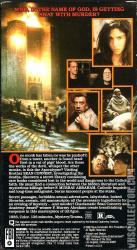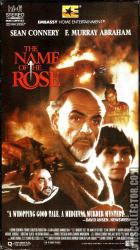The Name of the Rose
Catalog Number
1342
-
Primary Distributor (If not listed, select "OTHER")
Catalog Number
1342
Primary Distributor (If not listed, select "OTHER")
Release Year
Country
N/A (NTSC)
N/A | N/A | N/A
N/A | N/A
The Name of the Rose (1986)
Additional Information
Additional Information
Who, in the name of God, is getting away with murder?
A story of unholy murder.
Adapted from Umberto Eco's best-selling novel, director Jean-Jacques Annaud's The Name of the Rose is a 14th century murder-mystery thriller starring Sean Connery as a Sherlock Holmes-esque Franciscan monk called William of Baskerville. When a murder occurs at a secluded Benedictine Abbey, William is called in to investigate. As he and his apprentice, Adson von Melk (Christian Slater), delve deeper and deeper into the case, more dead bodies begin to turn up. Eventually, Bernardo Gui, an inquisitor played by F. Murray Abraham gets involved, but he may not have the best intentions. Sean Connery's performance earned him the award for Best Actor at the 1988 British Academy Awards.
The Name of the Rose (German: Der Name der Rose, Italian: Il nome della rosa, French: Le nom de la rose) is a 1986 film directed by Jean-Jacques Annaud, based on the book of the same name by Umberto Eco. Sean Connery is the Franciscan friar William of Baskerville and Christian Slater is his apprentice Adso of Melk, who are called upon to solve a deadly mystery in a medieval abbey.
Franciscan friar William of Baskerville and his novice, Adson of Melk (narrating as an old man), arrive at an early 14th century Benedictine abbey in Northern Italy. A mysterious death has occurred ahead of an important theological Church conference. William, known for his deductive and analytic mind, confronts the worried Abbot and gains permission to investigate the death – a young illuminator appears to have committed suicide. Over the next few days, several other bizarre deaths occur, and the two gradually discover that everything is not what it seems in the abbey.
William and Adson also make the acquaintance of Salvatore, a demented hunchback who speaks gibberish in various languages, and his handler and protector, Remigio da Varagine who, as events prove, also has a shady past. William quickly deduces from Salvatore's speech that he had once been a member of a heretical sect and infers that Salvatore and Remigio may have been involved in the killings. Meanwhile, Adson encounters a beautiful semi-feral peasant girl who has apparently sneaked into the abbey to trade sexual favours for food; she seduces him, and he falls in love with her.
Investigating and keen to head off accusations of demonic possession, the protagonists discover and explore a labyrinthine library in the abbey's forbidden principal tower. William is astonished to find that it is "one of the greatest libraries in all Christendom," containing dozens of works by Classical masters such as Aristotle, thought to have been lost for centuries. William deduces that the library is kept hidden because such advanced knowledge, coming from pagan philosophers, is difficult to reconcile with Christianity. It becomes clear that the only remaining copy of Aristotle's Second Book of Poetics is somehow related to the deaths. He further deduces that all of those who died had read the book.
His investigations are curtailed by the arrival of Bernardo Gui of the Inquisition, summoned for the conference and keen to prosecute those he deems responsible for the deaths. The two men clashed in the past, and the zealous inquisitor has no time for theories outside his own. Salvatore and the girl are found fighting over a black cockerel while in the presence of a black cat. Gui presents this as irrefutable proof that they are in league with Satan and tortures Salvatore into confessing. Salvatore, Remigio, and the girl are dragged before a tribunal, where Gui intimidates the Abbot into concurring with his judgment of heresy. But William, also "invited" by Gui to serve on the panel of judges, refuses to confirm the accusations of murder. Gui resorts to extracting a confession from Remigio by the threat of torture, and clearly plans to take care of William for good.
When another monk succumbs like the others, William and Adson ascend the forbidden library, and come face to face with the Venerable Jorge, the most ancient denizen of the abbey, with the book, which describes comedy and how it may be used to teach. Believing laughter and jocularity to be instruments of the Devil, Jorge has poisoned the pages to stop the spread of what he considers dangerous ideas: those reading it would ingest the poison as they licked their fingers to aid in turning pages. Confronted, Jorge throws over a candle, starting a blaze that quickly engulfs the library. William insists that Adson flee, as he manages to collect an inadequate armload of invaluable books to save; the volume of Poetics, Jorge, and the rest of the library are lost.
Meanwhile, Salvatore and Remigio have been burned at the stake. The girl has been slated for the same fate but local peasants take advantage of the chaos of the library fire to free her and turn on Gui. Gui attempts to flee but they throw his wagon off a cliff, to his death. William and Adson later take their leave. A much older Adson reflects in his closing narration that he never regretted his decision to continue on with William, and that the girl was the only earthly love of his life, yet he never learned her name.
The film did poorly at the box office in the United States, playing at only 176 theatres and grossing only $7.2 million in return on a $17 million budget.[3] However, it was popular in many parts of Europe and had a worldwide gross of over $77 million. It received generally positive reviews from American and Italian critics, with review aggregator Rotten Tomatoes giving it a 76% approval rating
They believed in God, but traded with the Devil
Release Date: September 26, 1987
Distrib: 20th Century Fox
Boxoffice: $7,153,487 2014: $15,348,200
A story of unholy murder.
Adapted from Umberto Eco's best-selling novel, director Jean-Jacques Annaud's The Name of the Rose is a 14th century murder-mystery thriller starring Sean Connery as a Sherlock Holmes-esque Franciscan monk called William of Baskerville. When a murder occurs at a secluded Benedictine Abbey, William is called in to investigate. As he and his apprentice, Adson von Melk (Christian Slater), delve deeper and deeper into the case, more dead bodies begin to turn up. Eventually, Bernardo Gui, an inquisitor played by F. Murray Abraham gets involved, but he may not have the best intentions. Sean Connery's performance earned him the award for Best Actor at the 1988 British Academy Awards.
The Name of the Rose (German: Der Name der Rose, Italian: Il nome della rosa, French: Le nom de la rose) is a 1986 film directed by Jean-Jacques Annaud, based on the book of the same name by Umberto Eco. Sean Connery is the Franciscan friar William of Baskerville and Christian Slater is his apprentice Adso of Melk, who are called upon to solve a deadly mystery in a medieval abbey.
Franciscan friar William of Baskerville and his novice, Adson of Melk (narrating as an old man), arrive at an early 14th century Benedictine abbey in Northern Italy. A mysterious death has occurred ahead of an important theological Church conference. William, known for his deductive and analytic mind, confronts the worried Abbot and gains permission to investigate the death – a young illuminator appears to have committed suicide. Over the next few days, several other bizarre deaths occur, and the two gradually discover that everything is not what it seems in the abbey.
William and Adson also make the acquaintance of Salvatore, a demented hunchback who speaks gibberish in various languages, and his handler and protector, Remigio da Varagine who, as events prove, also has a shady past. William quickly deduces from Salvatore's speech that he had once been a member of a heretical sect and infers that Salvatore and Remigio may have been involved in the killings. Meanwhile, Adson encounters a beautiful semi-feral peasant girl who has apparently sneaked into the abbey to trade sexual favours for food; she seduces him, and he falls in love with her.
Investigating and keen to head off accusations of demonic possession, the protagonists discover and explore a labyrinthine library in the abbey's forbidden principal tower. William is astonished to find that it is "one of the greatest libraries in all Christendom," containing dozens of works by Classical masters such as Aristotle, thought to have been lost for centuries. William deduces that the library is kept hidden because such advanced knowledge, coming from pagan philosophers, is difficult to reconcile with Christianity. It becomes clear that the only remaining copy of Aristotle's Second Book of Poetics is somehow related to the deaths. He further deduces that all of those who died had read the book.
His investigations are curtailed by the arrival of Bernardo Gui of the Inquisition, summoned for the conference and keen to prosecute those he deems responsible for the deaths. The two men clashed in the past, and the zealous inquisitor has no time for theories outside his own. Salvatore and the girl are found fighting over a black cockerel while in the presence of a black cat. Gui presents this as irrefutable proof that they are in league with Satan and tortures Salvatore into confessing. Salvatore, Remigio, and the girl are dragged before a tribunal, where Gui intimidates the Abbot into concurring with his judgment of heresy. But William, also "invited" by Gui to serve on the panel of judges, refuses to confirm the accusations of murder. Gui resorts to extracting a confession from Remigio by the threat of torture, and clearly plans to take care of William for good.
When another monk succumbs like the others, William and Adson ascend the forbidden library, and come face to face with the Venerable Jorge, the most ancient denizen of the abbey, with the book, which describes comedy and how it may be used to teach. Believing laughter and jocularity to be instruments of the Devil, Jorge has poisoned the pages to stop the spread of what he considers dangerous ideas: those reading it would ingest the poison as they licked their fingers to aid in turning pages. Confronted, Jorge throws over a candle, starting a blaze that quickly engulfs the library. William insists that Adson flee, as he manages to collect an inadequate armload of invaluable books to save; the volume of Poetics, Jorge, and the rest of the library are lost.
Meanwhile, Salvatore and Remigio have been burned at the stake. The girl has been slated for the same fate but local peasants take advantage of the chaos of the library fire to free her and turn on Gui. Gui attempts to flee but they throw his wagon off a cliff, to his death. William and Adson later take their leave. A much older Adson reflects in his closing narration that he never regretted his decision to continue on with William, and that the girl was the only earthly love of his life, yet he never learned her name.
The film did poorly at the box office in the United States, playing at only 176 theatres and grossing only $7.2 million in return on a $17 million budget.[3] However, it was popular in many parts of Europe and had a worldwide gross of over $77 million. It received generally positive reviews from American and Italian critics, with review aggregator Rotten Tomatoes giving it a 76% approval rating
They believed in God, but traded with the Devil
Release Date: September 26, 1987
Distrib: 20th Century Fox
Boxoffice: $7,153,487 2014: $15,348,200






Comments0
Login / Register to post comments